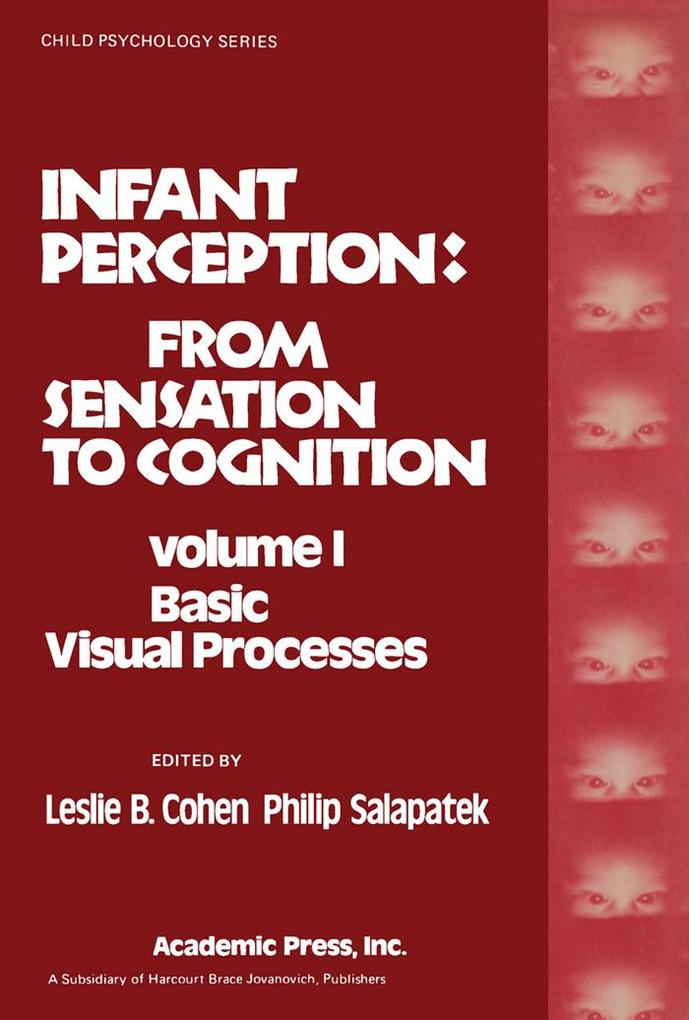
Sofort lieferbar (Download)
Infant Perception: From Sensation to Cognition, Volume I: Basic Visual Processes focuses on the study and programmatic investigations of infant perception, examining early sensory, perceptual, and cognitive systems.
This book is divided into five chapters. Chapter 1 analyzes the major physiological and behavioral techniques used to measure infant vision. Each technique is critically evaluated in terms of the method employed, type of data that can be obtained, and anatomy of the visual system. The neuronal model to explain developmental changes and techniques used to assess infant visual preferences for patterns varying in amount of contour are discussed in Chapter 2. Chapter 3 demonstrates the value of the corneal reflection technique for the study of infant attention and visual scanning patterns, while Chapter 4 examines the developmental changes and individual differences in early pattern perception. The last chapter concentrates on the evidence of infant visual preferences for novelty and on the implications of such evidence for models of early recognition memory.
This publication is a good reference for pediatricians and clinicians concerned with infant perception.
This book is divided into five chapters. Chapter 1 analyzes the major physiological and behavioral techniques used to measure infant vision. Each technique is critically evaluated in terms of the method employed, type of data that can be obtained, and anatomy of the visual system. The neuronal model to explain developmental changes and techniques used to assess infant visual preferences for patterns varying in amount of contour are discussed in Chapter 2. Chapter 3 demonstrates the value of the corneal reflection technique for the study of infant attention and visual scanning patterns, while Chapter 4 examines the developmental changes and individual differences in early pattern perception. The last chapter concentrates on the evidence of infant visual preferences for novelty and on the implications of such evidence for models of early recognition memory.
This publication is a good reference for pediatricians and clinicians concerned with infant perception.
Inhaltsverzeichnis
1;Front Cover;1 2;Basic Visual Processes;4 3;Copyright Page;5 4;Table of Contents;6 5;LIST OF CONTRIBUTORS;8 6;PREFACE;10 7;CONTENTS OF VOLUME II;14 8;Chapter 1. Infant Visual Perception: Methods of Study;18 8.1;I. Introduction;18 8.2;II. Anatomy;19 8.3;III. The Electroretinogram;27 8.4;IV. Visually Evoked Potential;39 8.5;V. Electrooculography;53 8.6;VI. Optokinetic Nystagmus;58 8.7;VII. Corneal Reflection;65 8.8;VIII. Conclusion;81 8.9;References;82 9;Chapter 2. A Neuronal Activity Model for Infant Visual Attention;94 9.1;I. Behavioral Preferences;95 9.2;II. Visual System Maturation Related to Pattern Processing at the Neurological Level;110 9.3;III. Measurement of Gross Electrical Phenomena Assumed to Correlate with Activity in Pools of Neurons;115 9.4;IV. Cortically Evoked Potentials;117 9.5;V. Infant Pattern-Dependent VEPs;121 9.6;VI. General Implications and Conclusions;137 9.7;VII. Summary;141 9.8;References;142 10;Chapter 3. Pattern Perception in Early Infancy;150 10.1;I. Introduction;150 10.2;II. Theories of Perceptual Learning and Development;151 10.3;III. Lines of Evidence Particularly Relevant to Innate Organization, Focal Processing, and Oculomotor Involvement in Perceptual Learning and Development;161 10.4;IV. Infant Research Relevant to the Issues Raised;193 10.5;V. Early Perceptual Development Reconsidered;243 10.6;VI. Two versus Three Dimensions, Figure versus Object, and Static versus Dynamic Cues: The Limitations of This Chapter;250 10.7;References;251 11;Chapter 4. Early Visual Selectivity;266 11.1;I. Introduction;266 11.2;II. Method and Concepts;267 11.3;III. Form Variations;275 11.4;IV. Quantitative Pattern Variations;302 11.5;V. Other Stimulus Variations;315 11.6;VI. Variations in Subject Samples;322 11.7;VII. Discussion and Theory;344 11.8;References;358 12;Chapter 5. Infant Visual Memory;364 12.1;I. Introduction;364 12.2;II. Qualitative Changes in Memory Development;366 12.3;III. Behaviors Implying Infant Memory;370 12.4;IV. Paired-Compariso
n versus Habituation Paradigms;374 12.5;V. Parameters Affecting Infant Recognition;382 12.6;VI. Models of Infant Habituation and Memory;407 12.7;VII. Summary and Conclusions;415 12.8;References;416 13;AUTHOR INDEX;422 14;SUBJECT INDEX;432
n versus Habituation Paradigms;374 12.5;V. Parameters Affecting Infant Recognition;382 12.6;VI. Models of Infant Habituation and Memory;407 12.7;VII. Summary and Conclusions;415 12.8;References;416 13;AUTHOR INDEX;422 14;SUBJECT INDEX;432
Produktdetails
Erscheinungsdatum
24. September 2013
Sprache
englisch
Seitenanzahl
442
Herausgegeben von
Leslie B. Cohen, Philip Salapatek
Verlag/Hersteller
Kopierschutz
mit Wasserzeichen versehen
Produktart
EBOOK
Dateiformat
PDF
ISBN
9781483271200
Entdecken Sie mehr
Bewertungen
0 Bewertungen
Es wurden noch keine Bewertungen abgegeben. Schreiben Sie die erste Bewertung zu "Infant Perception: from Sensation to Cognition" und helfen Sie damit anderen bei der Kaufentscheidung.









